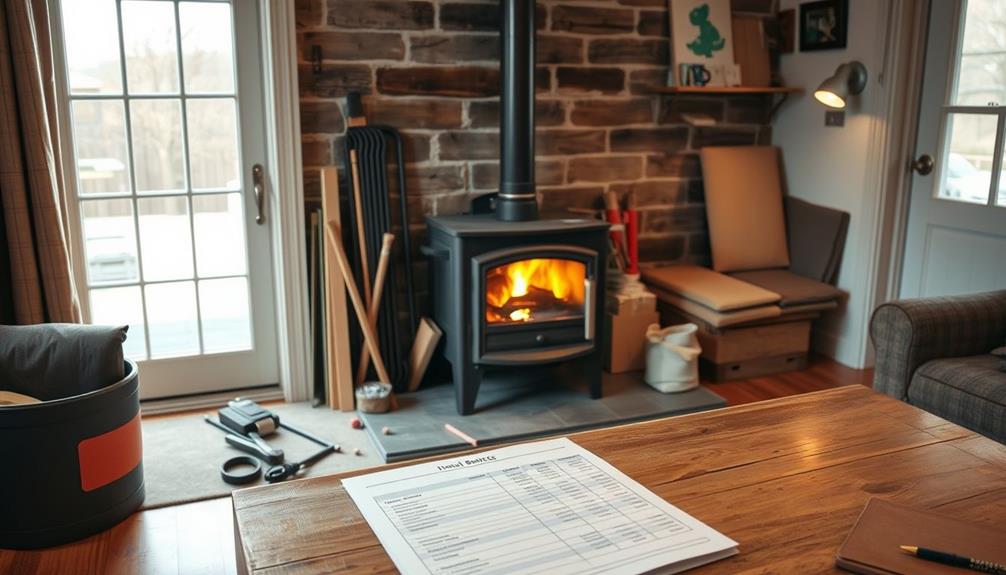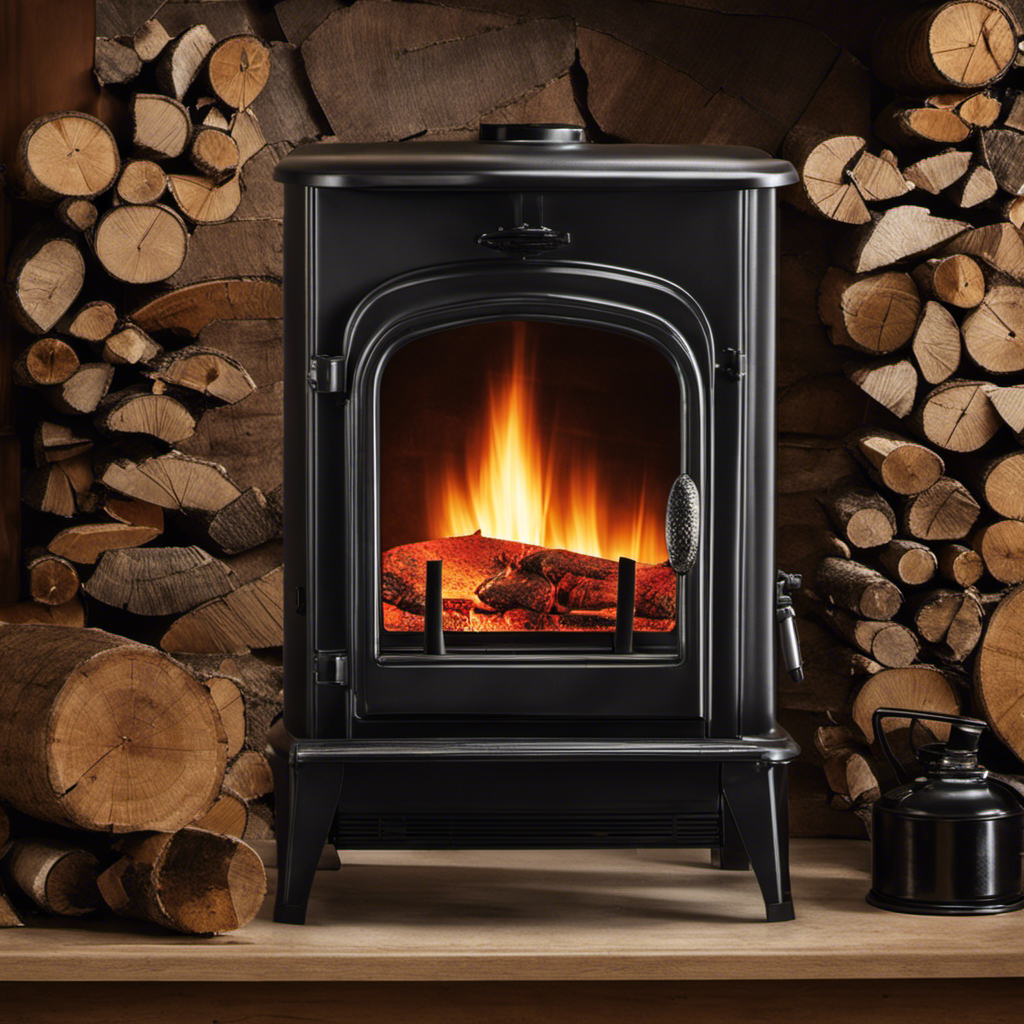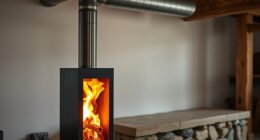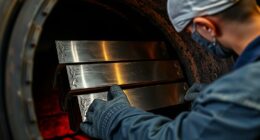If you are a homeowner thinking about getting a wood stove, you might be asking yourself, “What type of chimney do I need for this?”
Well, here’s an interesting statistic to start: Did you know that over 80% of chimney fires are caused by improper installation or maintenance?
That’s why it’s crucial to understand the requirements for a wood stove chimney. In this article, I’ll share the types of chimneys compatible with wood stoves, factors to consider when choosing one, proper sizing and installation, as well as essential maintenance and safety tips.
Let’s get started!

Key Takeaways
- Chimney installation and maintenance are crucial to prevent chimney fires caused by improper practices.
- Different types of chimneys are compatible with wood stoves, including stainless steel, double-wall insulated pipe, and masonry.
- Factors to consider when choosing a wood stove chimney include materials (stainless steel, galvanized steel, or masonry) and compliance with local building codes.
- Proper sizing and installation of a wood stove chimney are essential for effective smoke and gas removal, and professional installation is recommended for safety.
Understanding Wood Stove Chimney Requirements
I’ve been researching wood stove chimney requirements to figure out what kind of chimney I need for my wood stove.
When it comes to wood stove chimney materials, there are a few options to consider. The most common materials used for wood stove chimneys are stainless steel and masonry.
Stainless steel chimneys are easy to install and maintain, and they’re also more cost-effective compared to masonry chimneys.
On the other hand, masonry chimneys provide better insulation, which improves the overall efficiency of the wood stove. However, they’re more expensive to install and require regular maintenance.
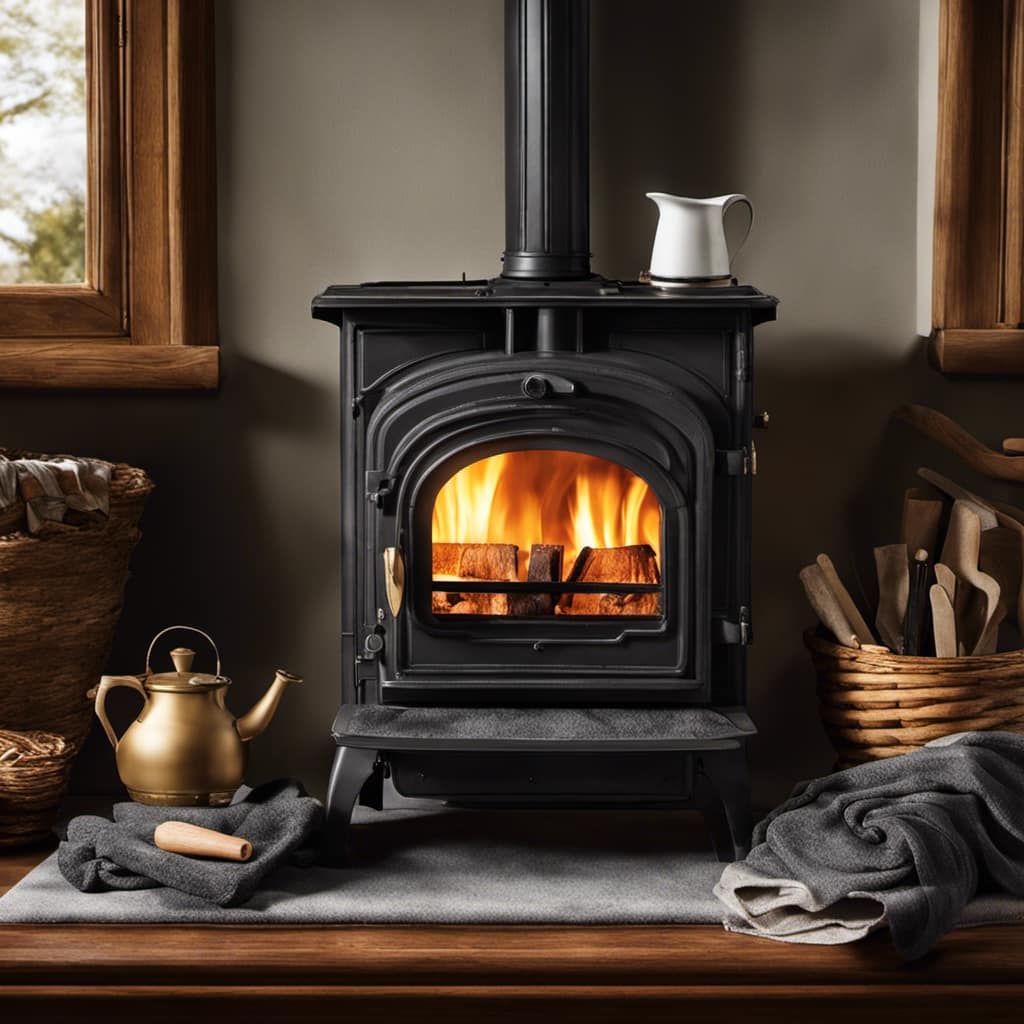
When considering the cost of installing a wood stove chimney, it’s important to factor in not just the initial installation costs but also the long-term maintenance and energy savings.
Types of Chimneys Compatible With Wood Stoves
I’m considering which type of venting system works best with my wood-burning stove. When it comes to selecting the right chimney for a wood stove, there are a few factors to consider. The first is the material of the chimney. Common materials for wood stove chimneys include stainless steel, double-wall insulated pipe, and masonry. Each material has its own advantages and considerations, such as durability, cost, and ease of installation.
Another important factor to consider is the height of the chimney. The height plays a crucial role in the proper functioning of the wood stove. A taller chimney helps create a stronger draft, which improves combustion efficiency and reduces the risk of smoke entering the room. It also helps to prevent downdrafts caused by wind.
Therefore, it’s recommended to have a chimney that extends at least 2 feet higher than any part of the roof within 10 feet of the chimney. Proper chimney height is essential for the safe and efficient operation of a wood stove.

Factors to Consider When Choosing a Wood Stove Chimney
When choosing a chimney for my wood stove, it’s important to consider factors like material, height, and proper installation.
Wood stove chimney materials can vary, but the most common options are stainless steel, galvanized steel, and masonry. Stainless steel is durable and resistant to corrosion, while galvanized steel is more affordable but may not last as long. Masonry chimneys are built from bricks or stones and offer a traditional and sturdy option.
Additionally, chimney height regulations are essential to follow for safety reasons. The height of the chimney will depend on factors such as the slope of the roof and the distance from nearby structures. It’s crucial to consult local building codes to ensure compliance and proper ventilation for the wood stove.
Proper installation is key to the efficient operation of the wood stove and the safety of your home.

Proper Sizing and Installation of a Wood Stove Chimney
The proper sizing and installation of a chimney are crucial for the efficient operation and safety of my home. When it comes to wood stove chimney installation, there are several factors that need to be considered.
Firstly, selecting the right materials is essential. Stainless steel and ceramic chimneys are popular choices due to their durability and resistance to high temperatures.
Additionally, proper sizing ensures that the chimney can effectively remove smoke and gases from the wood stove. It’s important to consult with a professional to determine the appropriate size based on the stove’s BTU output and the height and layout of the house.
By investing in the correct materials and sizing, I can ensure that my wood stove chimney operates efficiently and safely.

Now, let’s move on to the next section and explore maintenance and safety tips for wood stove chimneys.
Maintenance and Safety Tips for Wood Stove Chimneys
To ensure the safety and longevity of my home’s heating system, regular inspection and cleaning of the chimney are essential. A well-maintained chimney not only prevents common chimney problems but also ensures efficient performance of the wood stove. Here are some signs of chimney damage that homeowners should be aware of:
| Common Chimney Problems | Signs of Chimney Damage | Solutions |
|---|---|---|
| Creosote buildup | Black, shiny, tar-like substance | Regular chimney cleaning |
| Cracked chimney crown | Water leaks, crumbling mortar | Repair or replace the crown |
| Damaged flue liner | Smoke in the house, visible cracks | Relining or replacing the liner |
Regular inspections can help identify these issues early on, preventing further damage and potential safety hazards. It is recommended to have a professional chimney sweep perform these inspections and cleanings annually. Additionally, using a chimney cap and practicing safe wood-burning practices can help maintain the integrity of the chimney and ensure a safe and warm home.
Frequently Asked Questions
How Much Does a Wood Stove Chimney Cost?
The cost of a wood stove chimney can vary depending on several factors. These include the type of chimney, materials used, installation requirements, and any additional features. It’s important to consult with a professional to get an accurate estimate.

Can I Install a Wood Stove Chimney Myself, or Do I Need to Hire a Professional?
I can definitely install a wood stove chimney myself, but it’s important to weigh the pros and cons. While DIY saves money, a professional ensures safety and compliance with local regulations.
Are There Any Specific Building Codes or Regulations I Need to Follow When Installing a Wood Stove Chimney?
When installing a wood stove chimney, it’s important to adhere to building code requirements. Avoid common mistakes by ensuring proper clearance, using the right materials, and following manufacturer instructions for safe and efficient operation.
How Often Should I Have My Wood Stove Chimney Inspected and Cleaned?
Cleaning and inspecting my wood stove chimney regularly is crucial. Neglecting it can lead to dangerous buildup and potential fires. Look for signs like excessive smoke or a strong odor to determine when it needs cleaning.
Are There Any Special Precautions I Should Take to Prevent Chimney Fires With a Wood Stove Chimney?
When it comes to wood stove chimney safety, it’s important to take precautions and stay on top of chimney maintenance. Regular inspections and cleanings can help prevent chimney fires and ensure your wood stove operates efficiently.

Conclusion
In conclusion, choosing the right chimney for your wood stove is crucial for safety and efficiency.
By considering factors such as chimney type, sizing, and installation, you can ensure proper ventilation and minimize the risk of fire hazards.
Regular maintenance and following safety guidelines will further enhance the performance and longevity of your wood stove chimney.
Remember, a well-designed and properly installed chimney won’t only keep your home warm but also provide a cozy ambiance during those cold winter nights.
Growing up surrounded by the vast beauty of nature, Sierra was always drawn to the call of the wild. While others sought the comfort of the familiar, she ventured out, embracing the unpredictable and finding stories in the heartbeat of nature.
At the epicenter of every remarkable venture lies a dynamic team—a fusion of diverse talents, visions, and passions. The essence of Best Small Wood Stoves is crafted and refined by such a trio: Sierra, Logan, and Terra. Their collective expertise has transformed the platform into a leading authority on small wood stoves, radiating warmth and knowledge in equal measure.





